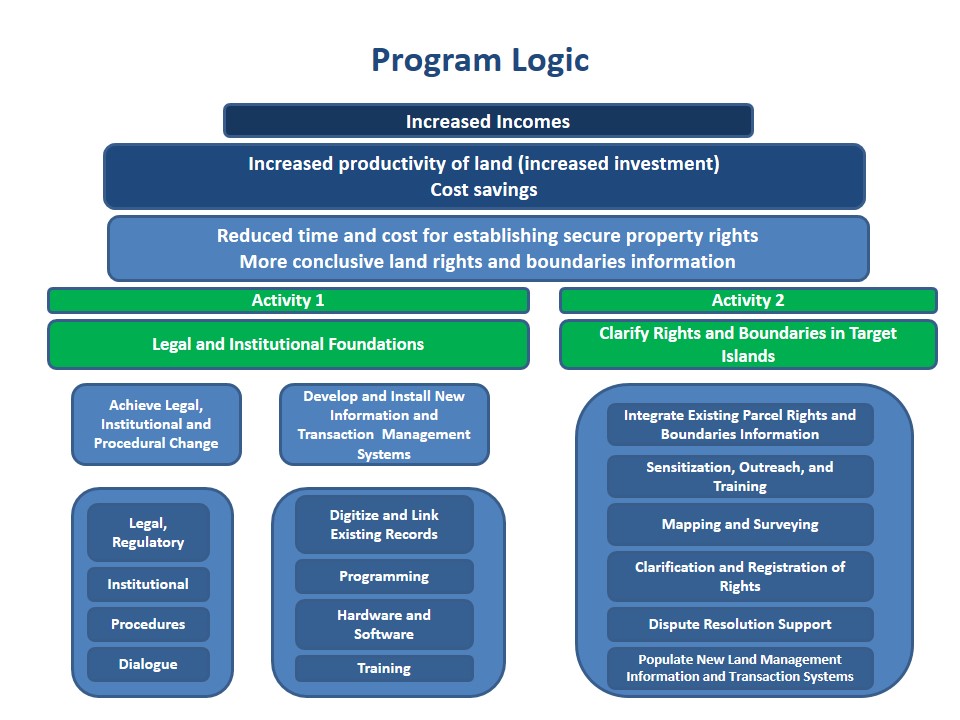
A sample program logic.
Developing a clear and well-defined program logic—the chain of events by which a given project is expected to lead to increased household income—is a crucial step in designing MCC projects. The clearer a project’s program logic, the easier it is to design activities, implement them, monitor them, and evaluate results.
As MCC assesses its portfolio from its first 10 years, what’s clear is that projects without well-defined program logics are much more difficult to implement and evaluate.
We also learned that having a clear program logic makes it a lot easier to explain:
- Why we are doing this project?
- What are the results we expect?
- What are the benefits of those results?
- What do we need to do to get there?
When a wide range of stakeholders understand a project and its intended outcomes, they are likely to be more engaged in implementing it and delivering results.
When decision-makers and stakeholders understand “why”, they can better explain the project to others, becoming more supportive advocates and champions. Finally, when decisions need to be made along the way due to budget or timeline issues, the program logic helps the team determine how proposed changes might affect achieving key outcomes and, ultimately, income growth.
MCC’s develops a program logic by:
Step 1: Defining the problem
Farmers’ incomes might be low, land rights might be hard to define or enforce, or rural populations might have limited access to irrigation or financial services. It is important to define the root causes of these problems and the economic challenges they create. For example, why are land rights difficult to enforce? What behaviors are affected by insecure land tenure? Do people invest less in their agricultural production than they might if they were more confident that they would reap the eventual gains? Do they spend an excessive amount of time resolving land-related disputes or attempting to complete land transactions?
Step 2: Identify the links between these problems and incomes
For MCC to make an investment, we need to demonstrate how it will result in higher incomes for beneficiaries. Determining the specific pathways through which incomes will rise is the tricky—but important—part. For example, do we hope that registering property rights will make landholders more secure? Do we envision then that they will make longer-term investments in their land through irrigation equipment, improved tools or perennial crops like fruit trees, increasing their land’s productivity and their incomes? Are there other ways to provide landholders with the security of ownership that might be less costly than registration? Or is the reason people aren’t planting perennial crops related to poor land-use planning in their village rather than insecure rights? Sector experts and economists at MCC and in partner countries must probe questions like these. .
Once we have defined the outcomes that lead to increased income, we must think strategically about the activities that will produce those outcomes. This means focusing on the outcomes that are essential for increased income and avoiding funding activities that matter less. For example, stakeholders might identify lack of credit as a constraint to increasing land productivity; however, the data does not link resolving land tenure problems to resolving the credit problem because there might be other reasons why access to credit is limited. In this example, a credit activity or credit-related outcomes may not be included among the proposed pieces of the project in the program logic.
Step 3: Use program logic to track progress toward results
MCC then uses program logic diagrams as guides in tracking progress on outcomes. The logic diagram will help the team select indicators to monitor throughout the compact and set realistic targets based on assumptions of how long it will take for certain activities to produce outcomes and for those outcomes, in turn, to produce increases in income. By returning often to the program logic, project teams and evaluators can make sure to ask the important questions, measure the right things and gather evaluation data at a time that makes logical sense.
Does your organization use a similar approach—or a completely different methodology—to define program logic and ensure that projects and activities lead to measurable results? Any suggestions to improve MCC’s approach?

